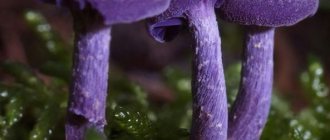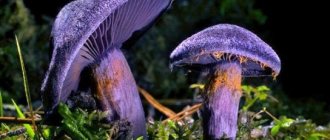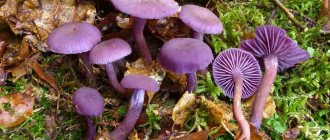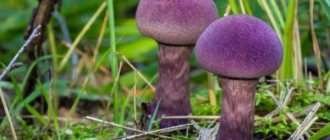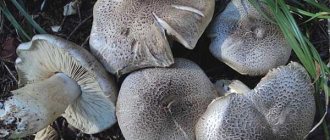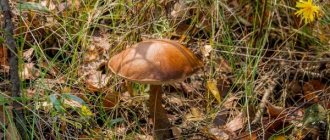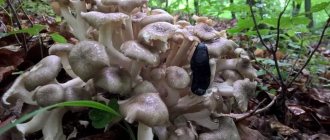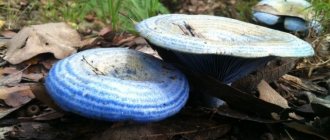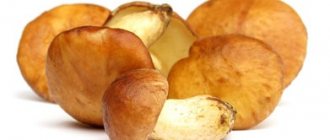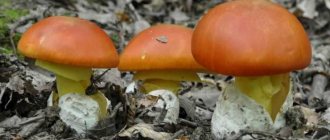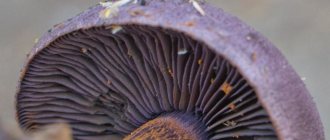Amethyst Laccaria Amethystina
A mushroom from the genus Lakovica, family Hydnangiaceae, also known as Lakovica Lilac. It was first described by the English botanist William Hudson in 1778.
Appearance
The cap is up to 5 cm in diameter, initially hemispherical, and over time, flat in shape. The hat is painted in beautiful purple shades that fade over time.
The hymenophore is lamellar, the plates are thin and sparse, descending along the stalk. Initially they are the same shade as the cap, but over time they acquire a powdery white color. White spore powder.
The stem is hollow, up to 10 cm high and up to 0.8 cm thick, longitudinally fibrous, slightly lighter in color than the cap. May fade to a whitish hue.
The pulp is thin, the same delicate purple color, with a pleasant taste and smell.
Where and when does it grow
It grows from July to October in forests of various types, loves moist soils and temperate climates. It often grows under beech and oak, and can grow in groups or singly. Peak fruiting occurs in September. In hot weather, the color of the fruiting bodies fades and there are fewer of them. In Russia it grows wherever there are suitable weather conditions.
Culinary use
The mushroom is edible and tastes quite good, although its small size makes it difficult to use as a “salt dish”. Most often it is added to other mushrooms as a kind of “mushroom seasoning”. And so it is suitable for any type of culinary use.
Taxonomy[edit]
The deceiver was first described by Tyrolian naturalist Giovanni Antonio Scopoli in 1772 as Agaricus laccatus
, before being given its current binomial name by Mordecai Cubitt Cooke in 1884. The specific epithet is derived from the Latin adjective
laccatus
“varnished” or “shining”.
Clitocybe laccata
is an old alternative name.
Var. pallidifolia
, described by Charles Horton Peck, is the commonest variety found in North America.
It is the type species of the cosmopolitan mushroom genus Laccaria
; where their relations lie among the gilled mushrooms is unclear, but they are currently classified in the family Hydnangiaceae.
The deceiver gets its common name from its variable appearance. Other names include lacklustre laccaria, and, by the Zapotec people, Beshia ladhi biinii
(also the name of other members of
Laccaria
).
Close relative
The Amethyst Lakovitsa has a very similar, and most importantly, edible and tasty, relative from the same genus and family.
This is the Pink Laccaria Lacata, also known as the Common Laccaria and the Laccaria Lacata.
Appearance
The cap is up to 6 cm in diameter, initially convex - depressed, then funnel-shaped. With age, the cap often cracks and acquires an uneven, wavy edge. The color of the cap varies greatly depending on humidity - from carrot-red and pink, in normal humidity, to yellowish and whitish, in very dry weather.
May show slight color zonation.
The hymenophore is lamellar, the plates are thick, wide and sparse, slightly descending, colored in the color of the cap and also change shade depending on humidity. Spore powder is white.
The leg is up to 10 cm long and up to 0.5 cm thick, cylindrical, elastic and hollow, often curved, with small white pubescence at the base. The stem is colored slightly darker than the cap and also changes color with changes in humidity.
The pulp is thin, without a distinct smell or taste, and is colored the same color as the cap.
Where and when does it grow
It grows from June to October, in various types of forests, gardens and parks. It prefers to grow on the edges of the forest and does not like places that are too dark, damp or, conversely, too dry.
This mushroom becomes very similar to the Amethyst's lacquer during the dry season, when both of these mushrooms fade and turn whitish. In this case, you can distinguish the Pink Lakovita from the Amethyst one by its slightly thicker stem. However, the degree of edibility and taste qualities of these mushrooms are the same.
Culinary use
The mushroom is edible and the same recommendations apply to it as for Amethyst Lakovitsa.
Harm and contraindications
Pink lacquer should not be consumed by pregnant and lactating women, as well as small children, because mushrooms themselves are heavy food. They are not recommended to be included in the diet of people who have problems with the stomach, liver, or pancreas. Patients with gout and other kidney diseases are not advised to use lacquers.
It is not advisable for healthy people to eat varnish often, so as not to cause disturbances in the functioning of the gastrointestinal tract. If you really want to eat mushrooms, it is better to cook them in several stages - boil for a long time, then fry and simmer. This treatment reduces the harmful effects of the product on the human body.
An important contraindication to the use of rose varnish is individual intolerance to the product. Such a reaction can be expressed in the form of allergies and disturbances in the gastrointestinal tract.
When going into the forest to look for common varnish, you should carefully study its external signs and look at a photo of the mushroom. It is important to remember its main distinguishing feature - the presence of dense pink plates. They are the ones who “give out” the mushroom, despite the large number of different shapes and colors of this species.
Mycena Pure Mycena Pura
Mushroom from the genus Mitsena, family Mitsena.
Appearance
The cap, up to 4 cm in diameter, is initially hemispherical in shape, then gradually becomes broadly conical, convex and, finally, can acquire an outstretched shape, sometimes with a raised edge. The surface of the cap is slightly slimy and has a pale brown color with a shade of gray. The color is darker in the center, and the edges of the cap are often furrowed and translucent.
The hymenophore is lamellar, the plates are sparse, of varying thickness, may be slightly wrinkled and have bridges at the base of the cap. The plates are painted in grayish-white shades, lighter at the edges. Spore powder is white.
The stalk is up to 9 cm long and up to 0.3 cm thick, smooth, cylindrical and fragile, with a matte coating at the top and long rough light hairs at the base. The stem is hollow; if it is broken, a large amount of liquid will be released from it.
The pulp is thin and watery, grayish in color and with a pronounced radish odor.
Where and when does it grow
Fruits from April to June, on dead or heavily mossy tree trunks. Prefers deciduous trees, but can also live on conifers. Quite widespread in Russia. This species of Mycena is listed in the Red Books in many countries of the world, but not in Russia.
Edibility problem
Mycena pure is usually classified as an inedible mushroom because of its strong, unpleasant odor, but some people discovered the dangerous substance muscarine in it, and generally classified it as a hallucinogenic mushroom.
Data on the hallucinogenicity of Mycena, however, are still very vague, as well as on its toxicity. There is information about both serious food poisoning with this mushroom and its consumption without any consequences. Therefore, we will put the question of the potential toxicity of Mycena out of the picture for now, but this mushroom does have an unpleasant odor, which deprives its consumption of any reasonable meaning.
Mycena Pure, in appearance, can be confused with the faded and old Lakovitsa Amethyst, but the characteristic smell of Mycena is unlikely to confuse these two mushrooms.
Cooking recipes
In cooking, pink varnish is prepared in different forms. However, it should be boiled before cooking.
Preliminary processing
After collection, the mushrooms are sorted and soaked in cold water for 30–40 minutes. After this, they must be boiled and the liquid drained, as it contains substances harmful to humans.
Cooking
Boil the mushroom whole or cut into pieces. The water should cover the product by 2 fingers.
Ingredients:
- water – 1.5 l;
- salt – 2 pinches;
- mushrooms – 500 g.
Step-by-step preparation:
- Chop the varnishes.
- Bring salted water to a boil.
- Place forest fruits in boiling water.
- Cook for 10–15 minutes.
- Drain the water through a colander (this will take 15-20 minutes).
Freezing
Mushrooms can be stored frozen for up to 6 months. After drying, the boiled hearth bodies are placed in freezer bags and sent to the freezer.
Frying
Mushrooms are fried after preliminary boiling.
The thickness of their layer in the frying pan should not exceed 3 cm. If desired, add onions and herbs to the dish. Lakovits go well with potatoes, which are often fried with them. Ingredients:
- boiled mushrooms – 500 g;
- 1 medium sized onion;
- dill – 20–30 g;
- butter or vegetable oil – 1 tbsp. l.;
- sour cream – 2 tbsp. l.;
- flour - 1 handful.
Cooking process:
- Melt butter in a frying pan or heat vegetable oil.
- Add boiled mushrooms.
- Fry until golden brown.
- Add onions, herbs and sour cream.
- Simmer for 10 minutes.
- Add flour and cook for 5 minutes.
Drying
Mushrooms are dried to obtain a powder, which is used in small quantities as a dietary supplement that promotes health. The product is placed in a dryer or the chopped fruiting bodies are hung on a string in a dry, ventilated place without direct sunlight. Ready mushrooms are crushed and stored in a glass container.
Roseweed is an edible mushroom that requires preliminary preparation before eating. If desired, the species can be grown in a summer cottage by planting mycelium. The healing properties of the mushroom are used in folk medicine and make it possible to treat a number of diseases and support the body as a whole.
Purple Web Spider Cortinarius Violaceus
Mushroom from the genus Cobweb, family Cobweb family.
Appearance
The cap is up to 15 cm in diameter, initially cushion-convex, with a drooping edge, then it can gradually change to flat. The cap is colored in dark purple shades and covered with small scales.
The hymenophore is lamellar, the plates are sparse and wide, dark purple in color. Often they are covered, characteristic of cobwebs, with a light transparent film. Spore powder is brownish-rusty in color.
The leg is up to 12 cm high and up to 2 cm thick, fibrous and with a tuberous thickening at the base, with small scales in the upper part, colored in dark purple or brownish shades.
The pulp is soft and thick, bluish in color, fading to white with age, has a very pleasant nutty taste and a faint odor.
Where and when does it grow
It grows in August and September in deciduous and coniferous forests, especially preferring pine groves. Quite common in Russia.
Is it possible to eat this mushroom
This mushroom belongs to the category of conditionally edible and is edible after a short boiling. It has a pleasant taste and is suitable both for fresh consumption and for storing for future use. There is one thing - the mushroom is listed in the Red Book, so we urge you not to cut it, but to admire its outlandish beauty from the outside.
The Violet webwort can be confused with the Amethyst varnish in color, but it is much larger in size, and its plates have a thin transparent “veil”, characteristic of cobwebs.
The benefits of the mushroom and its use in medicine
Pink lacquer was studied by scientists during the search for new medicines. It is valued not only for its nutritional, but also for its medicinal properties.
This type of varnish is a source of valuable antibiotics; it produces many substances, including:
- agrocybin;
- nemotin;
- polyporin;
- biformin.
Aqueous extracts of this mushroom can have a bactericidal effect, therefore in folk medicine it is used to treat infectious diseases that are caused by pathogenic microorganisms, these include:
- pneumonia;
- paratyphoid;
- peritonitis;
- salmonellosis;
- meningitis;
- chlamydia.
Pink varnish contains many vitamins and useful elements; in small quantities it has a beneficial effect on the functioning of the body, namely:
- strengthens the immune system;
- helps in the prevention of heart and vascular diseases;
- relieves irritation;
- normalizes metabolism.
It is advised to prepare dry powder of their mushrooms. In this form, the beneficial properties of the varnishes are preserved. They can be dried, ground and added as a seasoning to your favorite dishes. Mushroom powder is stored in a special cloth bag. This way it won't mold. It is recommended to include varnish in the diet no more than 2 times a week.
Artificial cultivation
It is quite possible to grow Amethyst Lakovita yourself in your garden plot. At least for aesthetic reasons - so that beautiful purple fungi grow in a free area of your garden, pleasing your eyes and heart.
To do this, you need to purchase mushroom mycelium from a specialized store, mix it with dry sand (500 grams of sand per square meter of soil), then dig a groove about 15 cm deep around a suitable tree, loosen its bottom well, and spread the mixture there evenly mycelium with sand and fill the groove on top with a layer of humus. Next, everything needs to be watered very thoroughly - at least 10 liters of water per square meter, and covered with soil that was previously removed when digging a ditch.
The mycelium will bear fruit for many years. It needs to be watered thoroughly during dry periods, and during periods when Lakovitsa does not bear fruit, it should be sprinkled with humus at the rate of 15 kg. per square meter.
Amethyst varnish is one of those mushrooms that delight us both in a plate, but even more right in the forest, giving the admiring connoisseur of quiet hunting an indescribable delight from contemplating their beautiful purple caps among the green forest grass.
False doubles
In nature, there are species similar to pink lacquer, most of which are not poisonous. But since there are also toxic lookalikes, you need to carefully look at photos of similar species in order to remember all the main differences:
- Lilac lacquer. An edible mushroom, in dry weather it becomes similar in color to pink lacquer. It is smaller in size, the plates under the cap are thinner.
- Honey fungus. Losing the intensity of color, the varnish becomes similar to honey mushrooms. Usually grows in groups. A distinctive feature of honey mushrooms is the presence of darker speckled freckles on the cap. They have a characteristic mushroom smell, which the varnish does not have.
- False scent. A poisonous mushroom, which its edible counterpart becomes similar to during drought. Unlike lacquer, the double has an intense yellow color and a smooth cap.
Collection rules
Common varnish usually grows in groups, from a few specimens to clearings filled with a continuous carpet of several square meters in area. You should collect healthy mushrooms, not moldy or dry. Bodies that are too overgrown should also not be taken.
Carefully cut with a knife at the base, without leaving a large stump. Sometimes it is advised to twist it out of the mycelium, removing the entire body. If in the future only the caps will be recycled, the stems can be carefully broken off and left in the forest.
Attention! Pink varnish accumulates in its body heavy metals from car exhaust and various toxins from contaminated soil and air. Therefore, collecting it along the highway or near landfills and burial grounds is life-threatening.
Use
Before using for cooking, common varnish must be soaked in cold water for an hour. Then rinse.
Pre-boiling
Since the sizes are small, you can cook rose varnishes whole or by cutting the caps into halves.
Required ingredients:
- water – 2 l;
- mushrooms – 0.7 kg;
- salt – 5 g.
Recipe:
- Place mushrooms in water and bring to a boil.
- Cook for 10–20 minutes.
- Strain through a colander.
The product is ready for further processing.
Frying
The taste of fried pink varnish is very similar to pearl puffball.
Required ingredients:
- pink varnishes – 1 kg;
- salt – 5 g;
- onions – 2 pcs.;
- greens, pepper to taste;
- vegetable oil – 2 tbsp. l.
Recipe:
- Pour oil into a preheated frying pan and add chopped onion into rings or strips.
- Fry the onion until golden brown, lay out the boiled mushrooms in an even layer.
- Salt, pepper, fry for 20 minutes.
- 5 minutes before ready, sprinkle with herbs.
If desired, this recipe can be varied: add sour cream and flour sauce, tomato, potatoes or eggplant.
Salting
Can be salted or marinated. Although due to their fragile structure they will not be particularly tasty.
Required ingredients:
- boiled varnishes – 3 kg;
- salt – 120 g;
- sugar – 15 g;
- fresh horseradish root – 80 g;
- horseradish leaf – 6 pcs.;
- garlic – 1 pc.;
- dill – 3 stems with umbrellas;
- peppercorns – 15 pcs.;
- bay leaf – 6 pcs.
Recipe:
- Place in enamel, glass or clean wooden containers in successive layers: a layer of greens, a layer of mushrooms, sprinkle with chopped onions and garlic, salt and sugar, repeat until the ingredients are gone. Finish with a layer of greenery.
- Place a clean plate or an inverted enamel lid on top, and place a load on top - a jar of water or a bottle.
- As soon as the juice appears, you can eat. As a rule, this takes 2-4 days.
Can also be dried to form a nutritious powder and frozen after pre-boiling or frying.
Definitioner
rare (rare smell)
In mycology, rare smell, English. "raphanoid" is interpreted very loosely and often refers to any smell of raw root vegetables, including potatoes, i.e. not necessarily as sharp, pungent and fresh as black or white radish.
Basidia (Basidia)
Lat. Basidia. A specialized structure of sexual reproduction in fungi, unique to basidiomycetes. Basidia are terminal (end) elements of hyphae of various shapes and sizes, on which spores develop exogenously (outside).
Basidia vary in structure and method of attachment to hyphae.
Based on the position relative to the axis of the hyphae to which they are attached, three types of basidia are distinguished:
Apical basidia are formed from the terminal cell of the hypha and are located parallel to its axis.
Pleurobasidia are formed from lateral processes and are located perpendicular to the axis of the hypha, which continues to grow and can form new processes with basidia.
Subbasidia are formed from a lateral process turned perpendicular to the hyphal axis, which stops growing after the formation of one basidium.
Based on morphology:
Holobasidia are single-celled basidia, not divided by septa (see Fig. A, D).
Phragmobasidia are divided by transverse or vertical septa, usually into four cells (see Fig. B, C).
By type of development:
The heterobasidium consists of two parts - the hypobasidium and the epibasidium developing from it, with septations (see Fig. C, B) or without them (see Fig. D).
Homobasidia is not divided into hypo- and epibasidia and in all cases is considered to be holobasidium (Fig. A).
The basidium is the site of karyogamy, meiosis, and the formation of basidiospores. Homobasidy, as a rule, is not functionally divided, and meiosis follows karyogamy. However, the basidia can be divided into probasidium, the site of karyogamy, and metabasidium, the site of meiosis. Probasidium is often a resting spore, for example in rust fungi. In such cases, the probasidium germinates into a metabasidium, in which meiosis occurs and on which basidiospores are formed (see Fig. E).
See Karyogamy, Meiosis, Hypha.
Pileipellis
Lat. Pileipellis, skin - a differentiated surface layer of the cap of agaricoid basidiomycetes. The structure of the skin in most cases differs from the inner flesh of the cap and may have a different structure. The structural features of pileipellis are often used as diagnostic characters in descriptions of fungal species.
Based on their structure, they are divided into four main types: cutis, trichoderma, hymeniderma and epithelium.
See Agaricoid fungi, Basidiomycete, Cutis, Trichoderma, Hymeniderma, Epithelium.
Kutis
The type of cap skin consists of creeping, ungelatinized hyphae located parallel to the surface. The surface of the cap looks smooth.
Lat. Cutis.
See Hypha.
Apiculus
1) Short growth at the end of the spore;
2) An extended short process of the basidiospore, with which it is attached to the sterigma.
See Hilar process.
